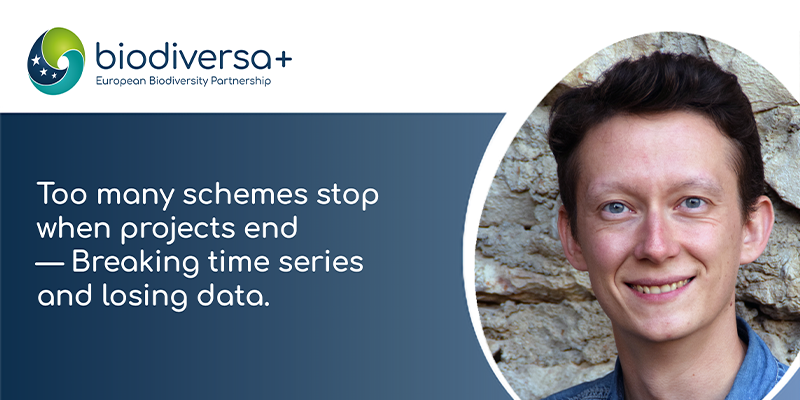What makes a biodiversity monitoring scheme truly sustainable? And what does it take to scale one up across borders? In other words: how do we deal with time and space? In connection with our Barcelona events, we sat down with Michele Bresadola to explore how Biodiversa+ is tackling these questions. At the heart of his task’s work lie two essential pillars: sustainability and transnationality.
Highlights:
- Effective biodiversity monitoring in Europe hinges on two pillars: sustainability (moving beyond short-term projects to secure diverse, resilient funding) and transnationality (scaling schemes across borders despite legal, logistical, and operational hurdles).
- Biodiversa+ is tackling this by identifying core monitoring costs, exploring diversified financial models, and developing a framework for assessing and selecting transnational schemes.
- The ultimate goal is to establish high-potential transnational monitoring schemes and resilient funding models, ensuring a robust and enduring European monitoring infrastructure that is crucial for biodiversity conservation.
Defining sustainability
“Many monitoring schemes are project-based,” Michele explains. “They run for a few years, then stop when funding ends or priorities shift.” This disrupts time series and leads to data gaps that make it harder to track biodiversity trends or support sound decisions.
To build lasting systems, Biodiversa+ is identifying the building blocks of sustainable monitoring. This includes estimating the core costs of essential functions like data collection, storage, and analysis, and distinguishing them from modular activities such as increasing the number of sites monitored or testing new technologies. “This helps us prioritise when resources are tight,” says Michele.
Financial strategy is another key area. Monitoring still relies heavily on national budgets, making it vulnerable to cuts and constrained by national rules. A major challenge, Michele notes, is to “disentangle” these limitations. “There are different ways to fund monitoring: national budgets, EU programmes, private foundations, and emerging mechanisms like biodiversity credits,” he explains. “We want to explore which sources are best suited for which parts of the scheme, to create a diversified, resilient financial model.” This kind of analysis helps not only with sustainability, but also with transparency and planning, helping governments and funders decide where and how to invest.
From national schemes to transnational coordination
The second focus is scaling monitoring schemes across borders. Biodiversity monitoring is often rooted in national contexts with limited cross-border coordination. “When we move to the transnational level, we face new legal, logistical, and operational hurdles,” Michele says.
Key questions arise: Who coordinates the network? How are roles distributed across countries? How is data shared? Crucially, how can we demonstrate the added value of such cooperation? Michele stresses the need to explain and showcase benefits to national actors, as cooperation at the transnational scale can also mean increased effort and potential costs.
From collaboration to consensus
A forthcoming report examines the coordination and funding mechanisms of existing transnational monitoring initiatives, such as those for birds and butterflies. It identifies two main models: top-down schemes driven by strong mandates (e.g., under the Water Framework Directive), and bottom-up networks where similar national efforts converge organically.
In parallel, the team is fine-tuning a framework for assessing and selecting transnational schemes. They are organising workshops with partners to agree on evaluation criteria such as policy relevance, data quality, and cross-border importance, and to assess partner readiness and institutional alignment. “It’s about balancing scientific rigour with practical usability, creating something that’s both robust and easy to apply, especially for decision-makers,” Michele explains.
Meanwhile, partners have received targeted funding to improve their national systems. This one-off support has allowed them to launch or scale up schemes, test new methods, or invest in capacity. While not a permanent solution, these efforts generate valuable insights and help build the national foundations for transnational coordination.
Connecting the dots across Biodiversa+
Michele’s work under Task 2.5 is closely linked with other strands of Biodiversa+’s monitoring activities. “It’s a two-way street,” he says. Some teams focus on coordination across borders, others on improving the cost-effectiveness and reach of monitoring itself.
Task 2.1 supports the identification of key common indicators and priorities, which is crucial for selecting policy-relevant schemes likely to attract funding. Task 2.2 works on harmonising methodologies and datasets, a foundational requirement for ensuring data interoperability across countries. Task 2.3 investigates the potential of innovative technologies and citizen science as cost-effective ways to expand monitoring coverage. Task 2.4 is assessing how biodiversity data is used by researchers and the private sector, with the aim of identifying new avenues for financial support. Finally, Task 2.6 runs pilot projects that serve as test cases to evaluate the practical challenges and sustainability of transnational monitoring schemes.
All this contributes to a more robust, connected, and future-proof monitoring landscape.
What success would look like
Within the next three to five years, Michele hopes to see two major outcomes. First, consensus on a few high-potential transnational schemes. “If we can agree, among partners and with the European Commission, on several schemes to run jointly, that would be a big step forward.” Second, practical tools and guidance for building resilient funding models. “We want to help national actors diversify their funding and invest strategically.”
He also sees a key role for the European Biodiversity Observation Coordination Centre (EBOCC), expected to provide coordination, templates, and funding for critical activities, especially those, like international data infrastructure, that are hard to fund nationally.
While progress might seem slow from a distance due to the scale of the undertaking, looking back, one realises the significant steps made since the beginning of Biodiversa+, and “if you’re on the ship, you can see people actively working, systems taking shape!” The destination? A sturdy monitoring ship, exactly what Europe needs to keep biodiversity afloat.
Update: Complement this read with the recently published report on implementing and sustaining long-term biodiversity monitoring schemes.




